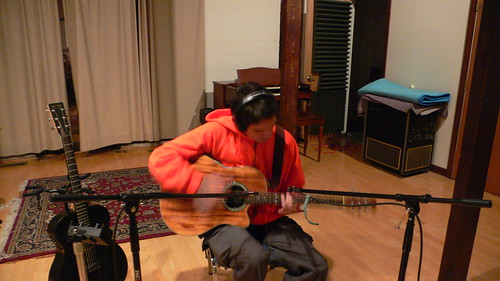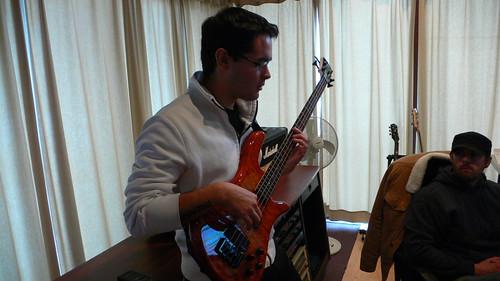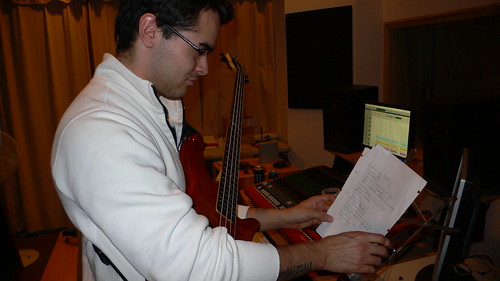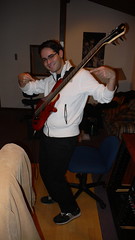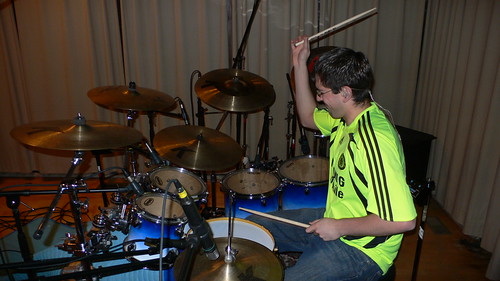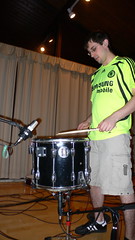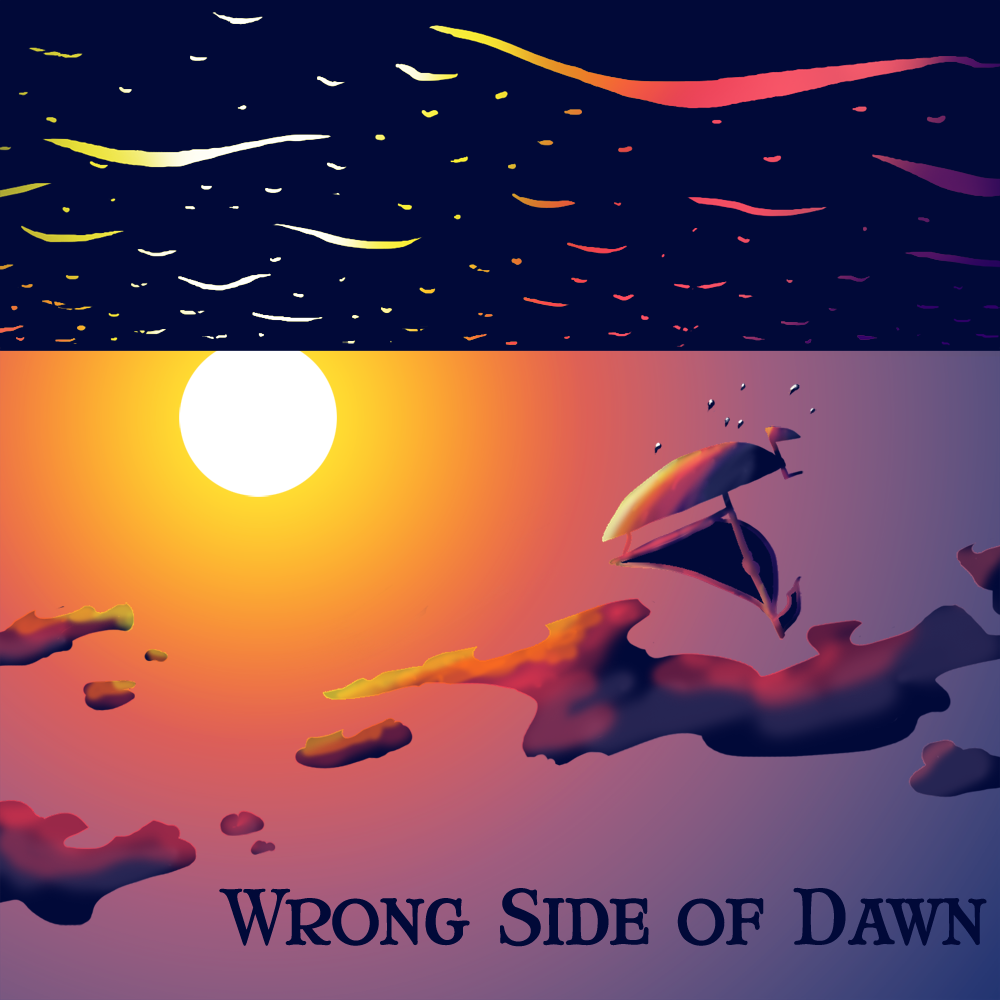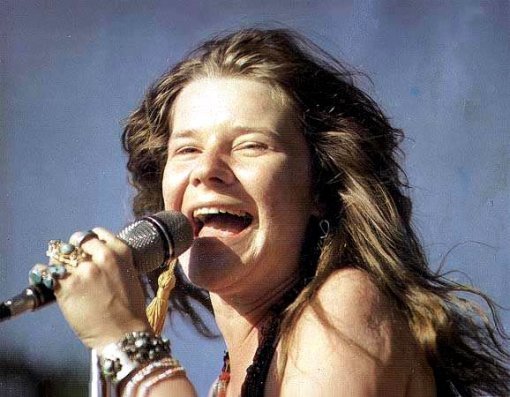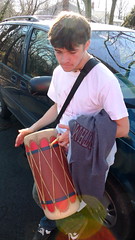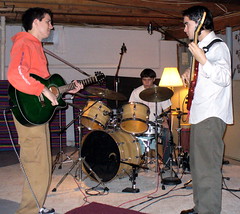Nelson and I recently got back in the studio for the first time in 3 months. Work on the Wrong Side of Dawn album has been suspended for a while, due to a lack of money, time and manpower. Though we’d hoped to be finished back in January or February, Nelson and I are happy to be back to work and hope to have things wrapped up, uh, someday.
The first song we worked on was the same song I had been working on when I was last in the studio, a song that will be titled either “Out of Time” or “Running Out of Time.” As we finished up with it, Michael Nuzzo, the owner of the studio, made a passing comment about the fact that the song “has something to it,” which is big for me because it’s one of the few times in my long history as an amateur songwriter that anyone outside of my own band has ever suggested to me that one of my songs has any redeeming qualities whatsoever.
“Running Out of Time” original demo:
Running Out of Time, mp3
Running Out of Time, lyrics
I wrote the rhythm guitar parts and chorus melody to the song more than four years ago, but never got around to writing some decent lyrics until about one year ago. I could say that sort of thing about a lot of songs, because lyrics are so goddamn hard to write. Strangely, these lyrics might be inspired by the song’s own guitar solo.
Last June, I was trying to record demos of some of my songs. I had three verses written for “Running Out of Time.” I had a chorus with some “whoa whoa” nonsense singing that still remains part of the song. I had one guitar solo in the middle. The song was supposed to end with the chorus being repeated over and over as everything faded out.
After recording bass and acoustic guitar, I took out my electric guitar to record the short solo in the middle of the song. After I finished, I started improvising just for fun, playing over the part at the end where I had recorded the chorus chord progression over and over in order to facilitate the fade-out. After playing around a little bit, I decided that this sounded pretty good, so I pressed record. On my first take I ran out of space. I hadn’t played through the chord progression enough times to accommodate all of my improvised ideas. After a couple more takes, the solo was condensed down to fit the space I had unintentionally allotted myself, and the solo I recorded then is basically the same solo I play now.
As I listened back to what I played, I decided that the song would have to end with this guitar solo, rather than the vocal chorus that I had planned. I also started to have second thoughts about my lyrics. A song with a guitar solo this good would need better lyrics than this.
I closed my eyes and listened back over the solo. Strangely, a memory popped into my head, a memory of playing in my yard when I was four.
Yeah, I remember when I was four. I guess some people don’t remember that far back, but I remember being two. My oldest memory is of my mother trying to explain to me what a birthday was, because the next day was going to be my third birthday. Since I didn’t know how to count, I don’t think I actually realized that I was two. I just knew that I was about to be three.
Where was I? Oh yeah, the guitar solo. I figured that something was nostalgic and backward-looking about the sound of the guitar. From that jumping-off point, I fashioned some lyrics that worked sort of in reverse chronological order. The first verse starts in the present, watching the sun rise (on the wrong side of dawn, in fact). The second verse recalls an old friend. The last verse looks back to childhood, when you did stuff just because it was there to be done. Then the last line says there’s no more time for that, but hey…. GUITAR SOLO!!!!!!!
On another subject, recording the “Out of Time” vocals in the studio provided me with an early moment of panic, when it initially turned out that I couldn’t hit the lower harmony on the intro of the song. Since I’d recorded the demo, my voice had apparently gotten… higher?!?!?!? Let’s go back and figure this out…
My senior year at Swat, I joined the chorus because I needed one year of participation in a performance ensemble to graduate with my music minor. Not confident that I could work my violin chops back up in time to join the orchestra, I approached John Alston about the possibility of joining the chorus. He asked me when was the last time I’d sung classical music. I said, “Eighth grade.” John seemed pretty concerned about my ability to keep up with his chorus. Good thing I didn’t tell him the truth: “Never, John. I barely listen to any classical music. But sing it? Never.”
I remember the first day that I showed up for chorus rehearsal. Some of my friends were in the chorus, and as I walked towards the men’s side of the room, clear confusion on my face as I tried to find a seat, they asked me, “Are you a bass or a tenor?” I didn’t know. I thought I could figure out a way to sing whatever I had to. The bass section was about three times the size of the tenor section, and the tenors seemed pretty desperate for some more support, so I sat down next to my friend Misha in the tenor section. This didn’t last. A shocked John Alston spotted me and had me move into the already overcrowded bass section. “What are you doing over there? You’re a baritone.” John had yet to actually hear me sing. It wasn’t until after that rehearsal that I would sing and barely pass my overdue audition. John had apparently gleaned my range just from talking to me.
He seemed to be right about me not being a tenor. I definitely got less comfortable as the notes got above middle C. Some of the lowest notes were also a problem too at first, but I was eventually pretty comfortable getting down to an E below the bass staff.
Fast forward to this year in Nuzzo’s studio: I’m trying to record the two-part harmony from the “Out of Time” intro. The lower half of the harmony goes down to a G, the one on the bottom line of the bass staff. Back in June when I made the demo? Piece of cake. Clearly within my range. Now, I’m doing take after take and I can’t quite get there. I’m getting a little panicked, since the clock is ticking by on my studio time, and Nelson and I have already spent more money on this than we planned.
Ever since graduation from Swarthmore, I do most of my singing while driving, singing along to the songs on my iPod. Most rock singers sing in the tenor range. Tough for me at first, but I got used to it. I thought my range was expanding. Apparently it wasn’t; it was just shifting. I never realized your voice could actually get HIGHER as you got older.
Nuzzo, the owner/producer/engineer/everything of the studio, is a school choir director. I expressed my frustrations at not being able to reach notes that were so easy less than a year ago. Not too long after John Alston was so surprised to see me sit down next to Misha in the tenor section, it was Nuzzo’s turn to be shocked. “You’re not a bass,” he said. “If you were in my choir I’d use you as a tenor.”
David Hume says we have no way of knowing that the future will be anything like the past, so for all I know I may wake up tomorrow making sounds that only dogs can hear. But this still seemed pretty weird to me. Anyways, Nuzzo managed to coach me through my own goddamn music until I got the G, and “(Running) Out of Time” is now recorded and ready to be mixed.
P.S. So when guys are stretching to sing higher, they joke around by pretending to squeeze their testicles. What is the equivalent when you’re trying to sing lower? Do you hold your hands down by your knees, palms up, like Tanaka talking to Pedro Cerrano (a.k.a. President Palmer/the “you’re in good hands with All State” dude/Dennis Haysbert) in Major League II? “You have no… you have no… …. MARBLES!! You have no marbles!”
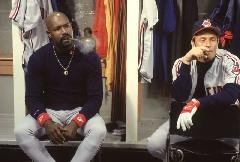
“Marbles? Huevos?”
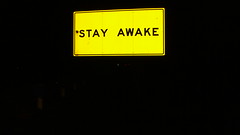

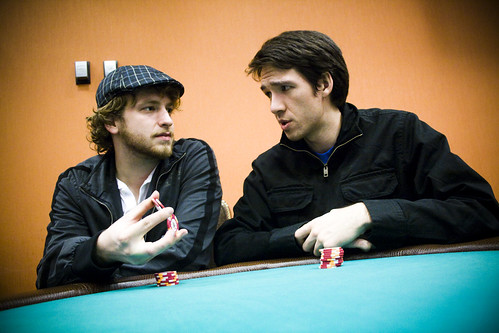



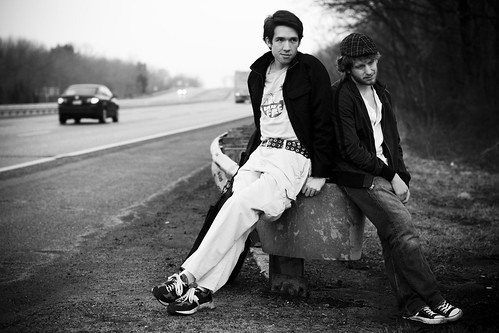
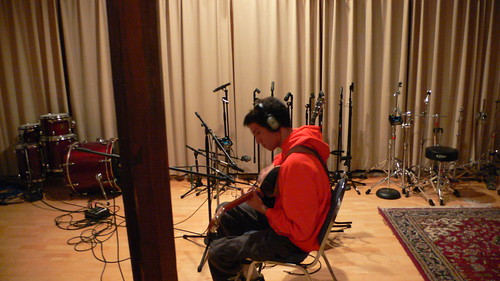
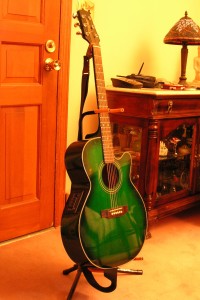 I am in love with my green Takamine acoustic-electric, named “Kermit”, and I would generally want to use it in any situation. However, recently Kermit has started going out of tune if I play high on the fretboard, and unfortunately many of our songs require me to do that. I didn’t have a chance to get Kermit’s problems checked out at the guitar store before recording started, so I had to use other guitars that were more in tune.
I am in love with my green Takamine acoustic-electric, named “Kermit”, and I would generally want to use it in any situation. However, recently Kermit has started going out of tune if I play high on the fretboard, and unfortunately many of our songs require me to do that. I didn’t have a chance to get Kermit’s problems checked out at the guitar store before recording started, so I had to use other guitars that were more in tune.